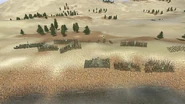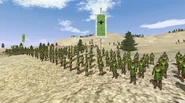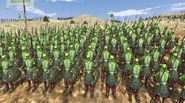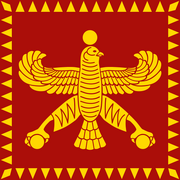
Flag of Darius III
The Achaemenid Empire (550 BC-330 BC) was the ruling dynasty of Persia for 220 years, founded by Cyrus the Great in 550 BC. During its existence, it ruled over Egypt, the Levant, the Middle East, Transoxania, and parts of The Balkans, the Caucasus, and Ukraine. It was conquered by Alexander the Great of Macedon in 330 BC.
History[]
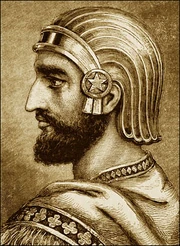
The Achaemenid empire was founded by Cyrus the Great in 550 BC, made up of the Persians, a tribe of nomadic people from present-day Iran. The Persians were victorious in the Persian Revolt of 552-550 BC, and they conquered Sardis from Lydia in 546 BC. In 539 BC, Cyrus also conquered the Chaldean Empire after winning at Opis and defeating Nabonidus in the Fall of Babylon. Babylon became the capital of Persia, and from there, Persia expanded. Cyrus built up a glorious civilization, and he was responsible for emancipating the slaves and Jews. In 525 BC, Cambyses II of Persia conquered Ancient Egypt after defeating Psammetichus III at the Battle of Pelusium, and from 499 to 493 BC the Persians put down the Ionian Revolt at the Siege of Naxos and the Battle of Lade.
With all of the Middle East, Asia Minor, and Egypt in their hands, the Persians continued on to pick new enemies: the Greeks. The Persians retaliated against Athens, Sparta, and the Greek Cities for their support of the Ionian revolt, with Darius the Great leading an invasion of Greece in 492 BC. Although the first invasion was curtailed by a storm, he invaded again in 490 BC and captured Eretria. In September, however, his army was defeated at the Battle of Marathon, although his army of 25,000 troops faced only 10,000 Greek troops. The Persians hurriedly re-embarked and retreated, and it would not be for another ten years that the Persians invaded Greece again.
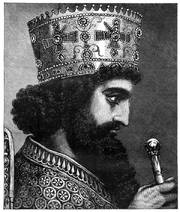
Darius' successor Xerxes I of Persia invaded Greece again in 480 BC, and his army of 200,000 Persian troops overran an army of 7,000 Greek troops in the Battle of Thermopylae in August 480 BC, although the courage of the defenders cost him 20,000 troops. The Persians won the Battle of Artemisium at sea the same month, but they lost the September Battle of Salamis, and in July 479 BC they were defeated at the Battle of Plataea, which ended their invasion of Greece. On 27 August 479 BC their army was also defeated at the Battle of Mycale on their own territory, and their last stronghold in Thrace, Byzantium, fell in 478 BC. This ended the Greco-Persian Wars, although the Greeks supported an Egyptian revolt in 462-454 BC with 200 ships, helping the 300,000 Egyptians fight the 400,000 Persians, although the Persians defeated the Egyptians after initial defeats at Pampremis and Memphis. Despite these embarrassing defeats, Persia recovered while the Greeks fought each other in the Peleponnesian War and joined Athens' side in the Corinthian War, helping the Athenians wipe out a Spartan fleet at the 394 BC Battle of Cnidus.
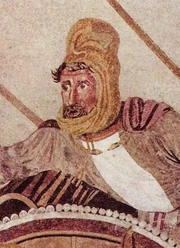
King Darius III of Persia at the Battle of Issus in 333 BC
In 336 BC, the Persian Empire faced its biggest and last issue when the King of Macedon, Alexander the Great, made plans to conquer Persia and avenge those killed in the Greco-Persian Wars a hundred years before. The Persians had a mighty navy located off the coast of Egypt, and they refitted at the docks of Memphis, Gaza, and Tyre. Alexander planned to capture the cities on land so that their navy could not repair itself, and he also planned a land advance to the cities of Persia with large armies. By the time he would be in the Persian heartland, he would start recruiting mercenaries, as Greek and Macedonian reinforcements would take months to arrive. He first fought the Persians in the 335 BC Battle of Halicarnassus, where he defeated the army of Memnon of Rhodes. Next, he proceeded to conquer the rest of Asia Minor, which was made easier after victories against the Persian army at the Battle of Granicus and the Siege of Halicarnassus in 334 BC. In 333 BC, he conquered the rest of Asia Minor and defeated King Darius III of Persia himself at the Battle of Issus. In 332 BC he conquered both Tyre and Gaza, and he was able to take control of Egypt without much opposition. The Persian Empire was rapidly conquered by the brilliant Alexander, who never lost a battle. In 331 BC he defeated Darius in person for a second time at the Battle of Gaugamela, and Darius was killed by his own rebellious satrap Bessus. Bessus himself was executed by Alexander out of respect for his former opponent Darius, and Alexander proceeded into Persia itself. He took Babylon, Ecbatana, and the other major cities, and in 330 BC he fought his last battle against Persia at the Battle of the Persian Gates. In that battle, the Persians held a narrow pass against Alexander's army for a month, but Alexander outflanked and defeated them with help from a local shepherd. With the last Persian army gone, Alexander was able to advance on Persepolis, which fell to him. Their last holdouts in Bactria fell without much opposition, and Alexander became the emperor of Persia and Macedon, ending the Achaemenid dynasty.

